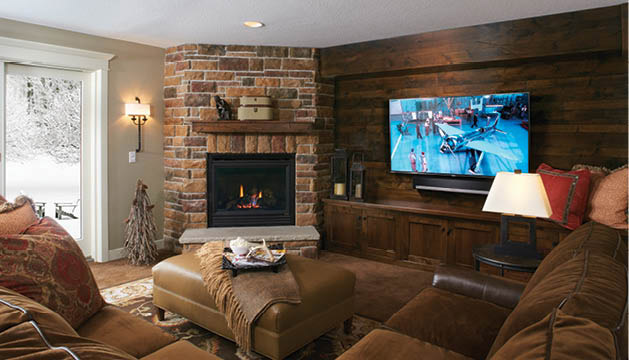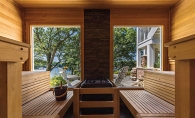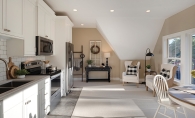Long gone are the days of ripping photos out of magazines to find inspiration for a living room makeover or bathroom renovation. Ever since websites like Pinterest and Houzz entered the scene, homeowners and designers alike have a plethora of design inspirations at their fingertips—literally.
With so many ideas floating around on the Internet, how has it influenced both designers and homeowners? We talked to three lake-area design firms to find out how they’re using online design sites to help their clients—and ultimately create beautiful spaces.
Getting inspired
When Nicole Nuckley and her family moved into their Minneapolis home, half of the large basement consisted of unfinished living space. In 2013, Nate Stangler, now the owner of Excelsior-based design and build firm Arbor Haus, and a team at another firm finished the remaining half of the basement to create a guest bedroom, bathroom, laundry room and craft room. Additionally, they turned the back porch into a mudroom.
Throughout the process, Nuckley found sites like Pinterest and Houzz (a home design website featuring interior design photos, home décor, decorating ideas and listings for home professionals) to be particularly helpful in the design and remodel process.
“In a very short period of time, you have access to a near-infinite visual list of what is possible,” she explains. “Using search tools, I could narrow what I saw to only things that were relevant for our space—and even then, there was still a vast number of design ideas, layouts and colors to sift through.”
But in the end, Nuckley says what she found most useful about these online design sites was the ability to find inspiration. Though she knew what styles and fixtures she preferred, she wanted to see how they would come together with other elements in a room.
Stangler thinks that pulling inspiration from online design sites this way can be really helpful in understanding what a person wants their home to look like. And even if he and his staff can’t re-create a certain pin or post exactly (whether it’s due to material availability or budget restrictions), it helps the design team figure out which direction to go.
“We try to deliver on the whole picture or pin—or make it look as close as possible” Stangler says. “But, a lot of times [homeowners] are willing to make small compromises on some things.”

Creating a vision
Interior designer Lora Marceau started her own Wayzata-based design firm Marceau Interiors nine years ago. Focusing mostly on homes in the Lake Minnetonka area, Marceau thinks that online design websites have made a great impact on her clients’ ability to communicate their design ideas. She says clients’ expectations of designers have always been high; however, the conversations inspired by online design sites and the insights gained from them have helped with the communication between designers and their clients.
With access to thousands of photos on sites like Pinterest and Houzz, homeowners can pull together their own ideas before even meeting with a designer.
“We all have iPads, and it’s a group of images all pinned onto one board or an idea book created on Houzz,” Marceau says. “So as a team of professionals sitting down, we are making great strides from the initial meeting. We all understand each other better from the get-go.”
Then, as projects continue, homeowners can continually add pins to their boards, keeping lines of communication strong throughout the process.
“When we can put all images neatly into one board and have them all laid out in one spot, the space starts to come alive and there is a feeling or attitude the client can start to visualize along with us,” Marceau says.

Honing the design
Julie Johnsen of Shoreline Builders in Wayzata has found that the homeowners they work with are becoming a part of the design process more than ever.
“They are able to transform their homes by visualizing what the project will look like and creating their own vision boards online,” Johnsen says.
For Nuckley, creating boards on Pinterest and idea books on Houzz helped her envision the space she wanted for their guest bedroom.
“I knew our guest bedroom would be a smaller room, so I wanted to see some clever ideas about how to maximize comfort,” Nuckley explains. “I had boards and books on both Pinterest and Houzz specifically for the project, so I could have everything organized in one place—in my ever-present phone.”
Not only have online design sites been helpful in cultivating the relationship between designers and homeowners, but they’ve also helped homeowners research and find the right designer for their projects. Through images, blogging, online newsletters, pins and tweets, clients can get to know a designer’s personality before even meeting them.
“There are so many ways a client can research to find the right fit for them [in a designer],” Marceau says. “That is one thing the online [design] sites have been increasingly good for.”

Pin Come to Life: D.I.Y. Headboard Wall
Give your bedroom a little pizazz with this simple headboard project.
You don’t have to buy a brand-new bed to give your bedroom a little facelift. Try covering the wall behind your bed with an uncommon material like reused pallets to create a budget-friendly wow factor. Here’s how:
- Round up some used wood pallets (for free!) from local retailers like home improvement stores, and even IKEA. Make sure to give them a good cleaning before you get started.
- Disassemble the pallets by pulling apart the boards. (Note: This is often a two-person job.)
- Decide if you want to keep the wood as is or amplify the color with a wood stain like Minwax. Apply lightly with a rag. Don’t forget to stain the edges of the wood, since they may show once installed.
- Find and mark all of your wall studs so you can nail the wood pieces in place. You can also choose to attach the wood pieces to a piece of plywood instead, which will make future removal easier.
- Start at the top of the wall and fit boards together by width before installing. Don’t begin a row until you’re sure you have enough of the same =width pieces to complete it. Then install each board separately with a nail gun. Check for gaps and level placement as you go.
- Pat yourself on the back for a job well done and admire your brand-new headboard.
Online Design Resources
Get inspired with the help of these five online design resources.
- Houzz: Millions of interior design photos, home décor, decorating ideas and listings for home professionals.
- Pinterest: A “visual discovery” tool that you can use to find ideas for all your projects and interests.
- Apartment Therapy: A wealth of online resources dedicated to helping people make their homes more beautiful and organized.
- Homedit: An online magazine with thousands of images and articles on interior design, architecture and décor.
- Young House Love: A DIY blog full of tips and tricks for design on a budget, written by a young couple in Richmond, Va.









